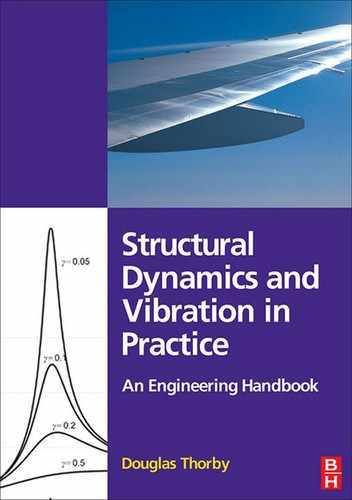Table of Contents
1.1 Statics, dynamics and structural dynamics
1.2 Coordinates, displacement, velocity and acceleration
1.4 Mass, stiffness and damping
1.5 Energy methods in structural dynamics
1.6 Linear and non-linear systems
Chapter 2: The Linear Single Degree of Freedom System: Classical Methods
2.1 Setting up the differential equation of motion
2.2 Free response of single-DOF systems by direct solution of the equation of motion
2.3 Forced response of the system by direct solution of the equation of motion
Chapter 3: The Linear Single Degree of Freedom System: Response in the Time Domain
3.3 Step-by-step numerical methods using approximate derivatives
Chapter 4: The Linear Single Degree of Freedom System: Response in the Frequency Domain
4.1 Response of a single degree of freedom system with applied force
4.2 Single-DOF system excited by base motion
4.4 Excitation by a rotating unbalance
5.1 Viscous and hysteretic damping models
5.3 Tests on damping materials
5.4 Quantifying linear damping
5.5 Heat dissipated by damping
5.8 Variation of damping and natural frequency in structures with amplitude and time
Chapter 6: Introduction to Multi-degree-of-freedom Systems
6.1 Setting up the equations of motion for simple, undamped, multi-DOF systems
6.2 Matrix methods for multi-DOF systems
6.4 Damping in multi-DOF systems
6.5 Response of multi-DOF systems by normal mode summation
6.6 Response of multi-DOF systems by direct integration
Chapter 7: Eigenvalues and Eigenvectors
7.1 The eigenvalue problem in standard form
7.2 Some basic methods for calculating real eigenvalues and eigenvectors
7.4 More advanced methods for extracting real eigenvalues and eigenvectors
7.5 Complex (damped) eigenvalues and eigenvectors
Chapter 8: Vibration of Structures
8.1 A historical view of structural dynamics methods
Chapter 9: Fourier Transformation and Related Topics
9.1 The Fourier series and its developments
9.2 The discrete Fourier transform
9.4 Response of systems to periodic vibration
10.1 Stationarity, ergodicity, expected and average values
10.2 Amplitude probability distribution and density functions
10.4 Response of a system to a single random input
10.5 Correlation functions and cross-power spectral density functions
10.6 The Response of structures to random inputs
10.7 Computing power spectra and correlation functions using the discrete Fourier transform
10.8 Fatigue due to random vibration
Chapter 11: Vibration Reduction
11.3 The damped vibration absorber
11.3.1 The Springless Vibration Absorber
Chapter 12: Introduction to Self-Excited Systems
12.1 Friction-induced vibration
13.2 Environmental vibration testing
13.3 Vibration fatigue testing in real time
13.4 Vibration testing equipment
A Short Table of Laplace Transforms
